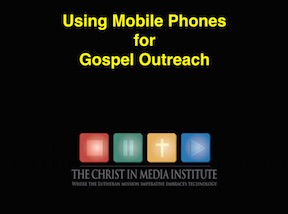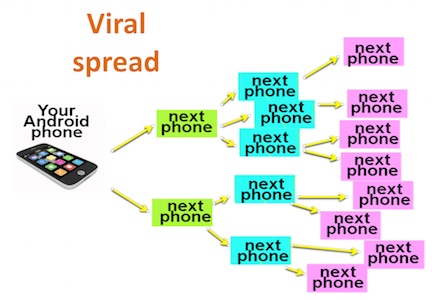
In these last days, God has given us a new "talent" to put to use: digital media, and the world-wide proliferation of devices for message delivery, mobile phones. Every mission station and congregation, in the US and abroad, should consider a mobile phone outreach plan as an important tool in their work.
Central in such a plan should be training in transferring Gospel-bearing media directly from one phone to another.
This presentation first explores WHY this is true, and then explains HOW to make it happen. In sum, here is what such a plan will involve, in three stages:
One: gather a "library" of useful Gospel-bearing files in digital formats.
Two: In each mission location, place these files on the mobile phones of key workers.
Three: Train these key workers in how to transfer these files to the phones of others.
Please note this: these do not necessarily have to be "smartphones." Many not-so-smart phones, if they can display photos and play music, will work with this system.
Why?
Why create a mobile phone outreach plan? What is the potential of such a mobile phone centered ministry?
Historically for outreach we've invested heavily in print – pamphlets, brochures, workbooks, and of course Bibles. Certainly for teaching and telling about Jesus, books will always be important, especially for helping new Christians become mature Christians. But for reaching the vast audiences around the world today who know little or nothing about Jesus, printed material is not ideal. It is expensive to produce, difficult and costly to ship and deliver, banned in many places, and in addition to all this, many people can't (or don't) read.
Enter cell phones. They are everywhere; there are more cell phones in the world than people in the world. Most of them (and soon virtually all of them) will display text files (for those who can read), play audio files, and display video files. Here are the benefits of a focus on cell phones for spreading the Gospel:
Free materials: Gospel-bearing materials are available in all of those formats – text, audio, and video – and can be obtained free of charge. (Of course, there is a cost for creating these files, but many producers make them freely available.)
Free delivery devices: There is no need for mission workers to purchase and distribute devices to carry the messages. The phones are already out there, everywhere. Thanks to commercial interests, cell-phone penetration is reaching the remotest jungle, desert, and mountain regions of the world, and the phones are there.

No internet required: In many parts of the world it is risky, even dangerous, to let anyone know you are interested in Christianity. Printed materials can be banned and confiscated, and even internet connections and downloads can be tracked. But a phone-to-phone transfer of a Gospel message is just that – between two phones. A telephone service contract isn't even needed, because it isn't a phone call. It's quite private.
Personal contact is central: While there are great blessings from using technology to broadcast Gospel messages via radio, TV, and satellite, there will never be a substitute for person-to-person witnessing – one Christian believer talking to a co-worker, friend, or relative about Jesus. Cell-phone outreach combines technology with personal contact. Conversation and file-transfers happen together over a relationship. Imagine this conversation (which could happen in virtually any language):
"Here, want to watch this video I have on my cell phone?"
"A video on your phone? Sure, what is it?"
"Take a look."
(Shows 1 minute video clip about the resurrection of Jesus, the angel announcing to the women, "Why are you looking for the living among the dead?")
"Pretty cool. I didn't realize you could watch videos on your phone."
"Even more amazing, that really happened, you know. Jesus really did rise from the dead. Do you know what that means for YOU?"
(They talk. Finally…)
"Do you want this video on your phone? I could transfer it to you."
"Yes, I'd like to show my family."
(A few key clicks and the video is on the other person's phone.)
From there it might be transferred to other phones, and who knows how far it will go?
How?
It is not hard to set up a mobile phone outreach component in your mission.
First let me say this: it is not ideal to leave this task to the pastor or the missionary. There is a time commitment involved, the pastor/missionary might not be the most tech-savvy person in the mission, and besides, they are very busy being the pastor or missionary. Better to find a capable member in the mission – maybe a teenager – who can take on this project. We at the Christ in Media Institute will be happy to be in contact with this person for whatever training and guidance is needed.
Here is the task in more detail:
One: gather a "library" of useful Gospel-bearing files in digital formats.
Some of these are already freely available (see Judy Kuster's presentation); we are becoming adept at creating others ourselves.
Contents of the files:
Audio Bibles: Our favorite. Getting people to listen to the Bible on their phones is a major goal – especially among people and cultures where literacy is limited. More than that, many can listen to God's Word in their own birth language; as of this writing, the Bible.is website has free audio Bibles (New Testaments, and entire Bibles in many cases) in nearly 1200 languages.
Music: Good Christian music is out there, or record your own mission choir and church musicians and put the songs on phones.
Audio instruction: Have a local person read the Catechism into a recording device, and then people of limited literacy can listen to it on their phones in their own language.
Videos of the Bible: The "Jesus" film (1979) is pretty good and is available free. While few people would watch the entire 90 minute movie on their small phone screen, the movie has been cut up into short clips (the birth of Jesus, the Lord's Prayer, the resurrection, 61 clips in all) that can easily be viewed and transferred on phones. Of course, "Road to Emmaus," "Come Follow Me," and "My Son, My Savior" (and clips from them) are also becoming available in several languages.
Bible story slide shows: lots of them are available, for adults and for children.
Text files, for those who can read: The Bible, of course, in many languages, Luther's Small Catechism, and any of the many materials already available on paper can be digitized for viewing on a phone screen.
For much more on available materials, see the presentation by Judy Kuster.
Kinds of files:
Video files in the .mp4 format will play on most phones, residing under the "video" icon. There are slight variations in .mp4 files and countless variations among phones, so occasionally some files won't play on some phones. But those files can be fixed; contact the Christ in Media Institute or WELS Multi-Language Publications for advice.
Audio files in the .mp3 format will play on most phones, stored under the "music" icon on the phone.
Text files in .pdf format, as well as pages of text that have been photographed in .jpg format, will show up on the phone under "photos" or "pictures."
Two: Place these files on the mobile phones of willing workers.
These key workers not only enjoy the files on their own phones, but are willing to send those files to the phones of others – family members, friends, co-workers.
There are two ways to get files onto these key phones. One is the phone-to-phone transfer process described below, a one-file-at-a-time process that is central to personal outreach but rather slow for loading a large number of files. For this, the better way is to load the files from a computer onto micro-SD memory chips, which can then be inserted into the slots on most Android phones.
Three: Train the workers how to transfer files from their phones to the phones of others.

This can be done without an internet connection, and it's not even a phone call. Files go directly from one phone to another without wires. For example, a video about Jesus' resurrection can be sent from the first phone to that of a friend; that friend in turn could as easily pass the video on to a co-worker, who brings it home and sends it to the phone of a family member, and so on – the message can spread (as they say in the digital world) virally.
Training can focus on two skills:
- How to transfer files phone-to-phone. This is a routine procedure, easy once a person has done it a few times, but requiring several steps. In the conference session "Instructional Video – Phone to Phone Transfers" you can download a video to use in a training session, showing the process step by step, pausing at each step while the people actually do on their phones what is shown. A verbal description of the process is also included.
- How to approach people. With your team, discuss, plan and practice (role play) some strategies for how to direct the attention of people – friends, family, co-workers – to the video about Jesus on your phone. Then plan some follow-up questions to continue the conversation about Jesus in their life. There may be other clips on the phone to view together. At least, there will be an invitation: "Come to church and learn more."
It's a simple but, under the Holy Spirit, a potentially powerful process. The phones are everywhere, the materials are available, the fields are white, and the Lord is coming soon.
As of this writing, the Christ in Media Institute has offered and/or sent to a number of countries Gospel-bearing files formatted for cellphone transfer. These files, in the local languages, are primarily audio Bibles from bible.is and short video clips from "Come Follow Me" and the Jesus film. This table shows the countries and languages.
| Albania | Albanian (Shqip) |
| Cameroon | Bafut, Pidgin, English, French |
| China | Mandarin |
| Ethiopia | Nuer |
| Haiti | Haitian Creole |
| India | English, Hindi, Telugu |
| Indonesia | Indonesian, Malay Bahasa, English |
| Korea | Korean North, Korean South |
| Laos | Lao |
| Macedonia | Greek |
| Malawi | Chichewa, Chitumbuka |
| Mexico | Spanish, Yucatan Mayan |
| Nepal | Nepali, Lhasa |
| Pakistan | Urdu |
| Sudan | Nuer |
| Uganda | Luganda |
| Vietnam | Vietnamese, Hmong Daw, Hmong Shaud, Hmong Njua |
| Zambia | Chichewa |
Other resource sites for mobile ministry:
Mobile Ministry Forum offers useful online courses and hosts an annual conference.
Visual Story Network connects with many experienced and dedicated workers.
Return to original language with "show original" button at top left.

Discussion